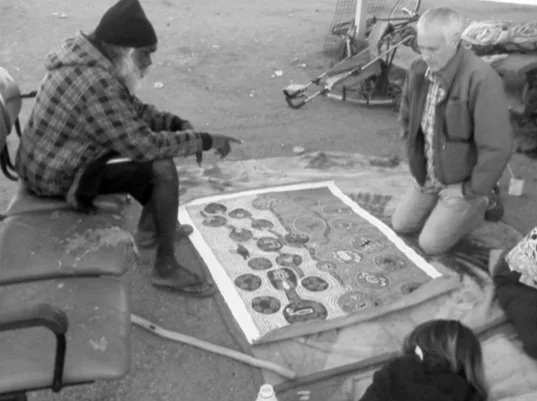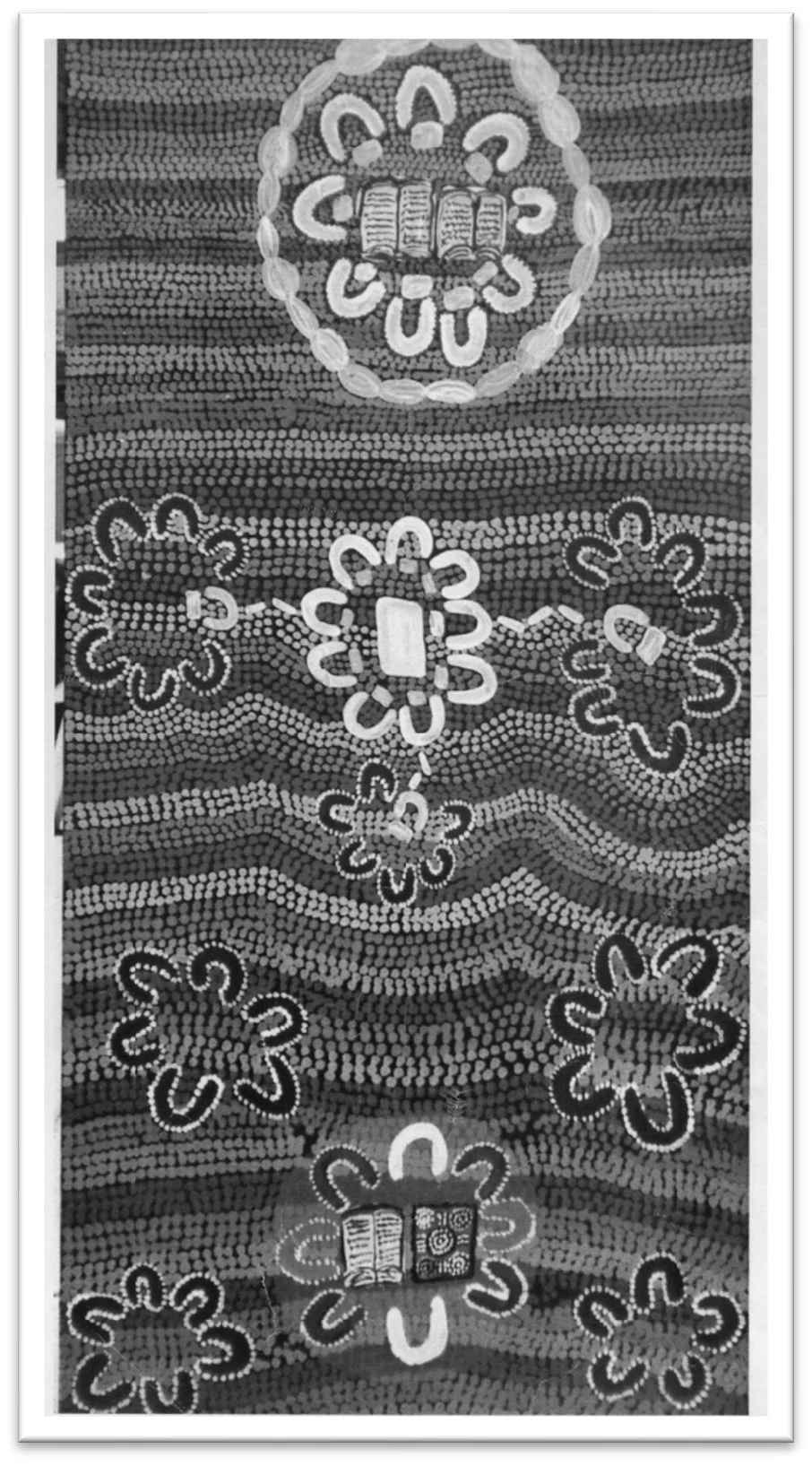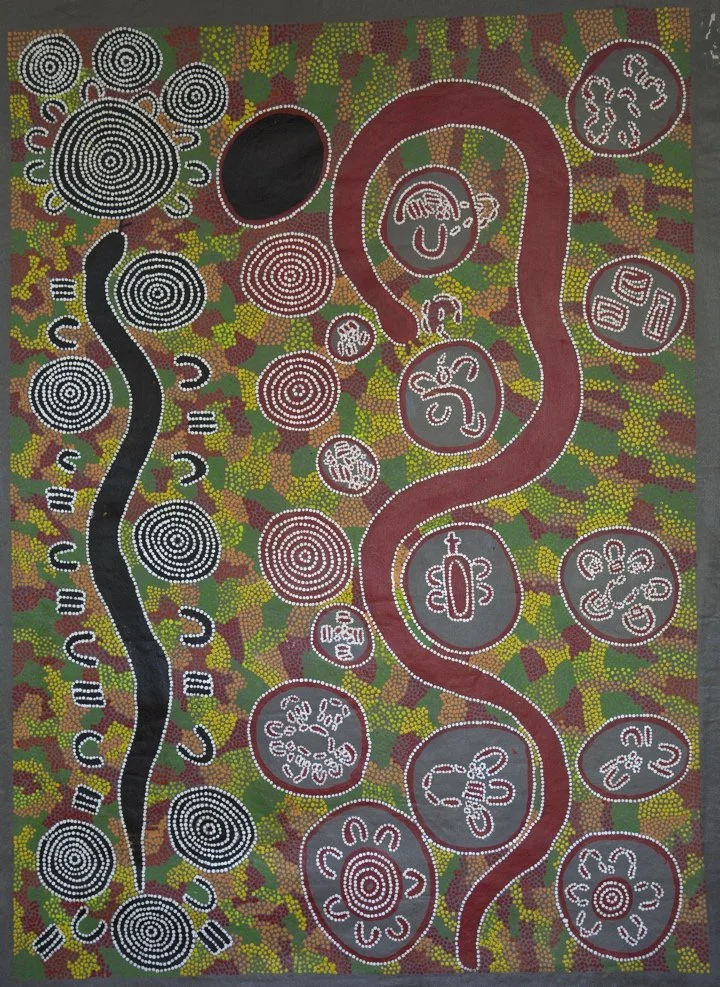Japaljarri's vision
Craig San Roque
Ground Grounding
Eagle and Crow
Two men – on the ground – a town camp –- Alice Springs. The one, a psychiatrist, Dr Marcus. The other, Japaljarri Spencer. The painting is one of several by Japaljarri, a Warlpiri-Pintubi man known for depicting, in Warlpiri iconography, the existential conditions of Aboriginal people in our region.
As Ken Lechleitner has said: ‘Japaljarri was a revolutionary thinker.’
This painting, Eagle and Crow, shows the life story of a man and a decisive moment of choice. Crow, the marauder, urges the man to live as he wants:
‘It’s your life; you’re free to go drinking, fighting, leaving kids, not sticking to culture/jukurrpa, not thinking. No law.’ The Eagle comes down lifting the man into the sky. ‘Look,’ says Eagle, ‘White people are there, true. Yes, this
is our life now. Look at it. Don’t give up – don’t give up our culture – learn to manage the whiteman. You can handle the two ways.’
Eagle shows him how. He shows him a way that Warlpiri man can hold two cultures together.
This Eagle and Crow story is a Japaljarri vision. I remember the time he clarified his thinking on this two way busines. This is a painting inspired from that point; lifted up in Eagle’s claw, where Japaljarri found himself – gaining perspective, strengthening his decision to work with two way understanding. It was part of a long hard process over his lifetime. There are many men and women in Central Australia who hold to this two way vision. And there are many who follow Crow.
The stories I tell you here are from 30 years in Central Australia. I am among people such as these two here. On the ground, working together.
Consider the position of the two men: gazing at the painting between them, with other younger family listening in; they are not in a consulting room. They are consultants to each other. Two doctors diagnosing a situation – seeking a way through.
This setup gives a living local instance of the psychotherapeutic idea of Potential Space as developed from DW Winnicott. The ‘potential space’ idea is one guiding psychoanalytic idea that has been especially helpful for me in this area between two worlds. Two way learning, two way therapy is about finding and creating a flexible area of relationship between black and white – between Japaljarri and me; between Marcus and Japaljarri – between any of us who work within the conflicts of interest – between destruction and creation.
Two way work does take a place in Central Australian culture because many Indigenous people patiently, cannily, initiate the reciprocity – and hold to it (with good humour). Yet, alas, many Australians refuse to hold to that potential interactive relationship, striving to ignore, override, manipulate, obliterate truth-filled psychic linking. We have not yet, truly, formed the discipline of it.
There is another psychoanalytic idea that has helped me – the notion of ‘transference’ – redeveloped not in consulting rooms but on the roads and camps of bush communities. I mean the inter-personal/ inter-cultural transference dynamics operating between ‘black’ and ‘white’ people. We could look more deeply into the movements and intensities of this strange Australian, intercultural, unconscious transference and projection dynamic. Things go on beneath the ground between black psyche and white psyche. Between parallel lines of cultural influence..
The image of the doctor and Japaljarri considering the fate of the man caught between Eagle and Crow is, for me, a figure of Winnicott’s potential space dynamic. The scenario is a living instance of the many dynamics in play between (thoughtful) people seeking two way knowledge, truth and solution to a mutual therapeutic puzzle.
Now let us pass on to another painting by Japaljarri Spencer. He formulated this in 1990-91 when working with the Healthy Aboriginal Life Team ( HALT) – a substance abuse prevention group. The painting is said to have been in the office of Prime Minister Keating, as a guide for governance in Indigenous affairs. This is a diagram of three possible scenarios of two way governance.
Two Way Governance
Japaljarri Spencer on how Australian institutions deal with Aboriginal affairs.
Image sequence top to bottom. Horseshoe shapes represent people sitting.
A big table ( in Canberra) – all white people using documents, enclosed in white cloud, thinking on their own.
In Alice Springs – the white table figure is repeated. White people have their backs to people in the country around.
‘White table’ sends white people to communities with white document. Each white person enters the circle of black people, taking positions of importance in centre of meetings. Back figures who have their own system of discussion and consensus in the circular kin-based pattern.Two way pattern includes people – white, brown (i.e., mixed language speakers) and black – all in a circle with two cultural formats of the business – paper and painting – two ways of thinking on issues at hand. After consensus the message is carried home to communities. You see the black figures travelling home – maybe to Kintore or Yuendumu. The message is carried in the language of local people. Two way work. Language work.
Therapy interventions
Let’s look at the Japaljarri pattern from the point of view of ‘therapy interventions’. I suggest a few sample self-questions.
Scenario 1
At the white table, health service managers are planning (mental) health interventions within Aboriginal country – whose ideas do they project into practice? From whence comes the theory, the clinical experience upon which managers rely?
Scenario 2
How do health professionals moving to the black circles (communities) match their minds and reporting with Indigenous mentality/reality? The lines of accountability to the ‘white table’ must always be managed. Yet how, and with what intelligence? Have you noticed
yourself carrying a favoured therapy theory into the heart of Aboriginal conversations – bundled with good intentions, suffused with unconscious anxiety? What is your conversational model of two-way work?
Scenario 3
In clinically responsible detail – What is the exact nature of the professional conversations taking place between the white, brown and black, multilingual persons seated in Japaljarri’s third scenario. What language? What understandings? What consensus of mind on the ground? What exact steps of engagement with what person/patient family member. What documentation?
Responses
Consider examples of culturally determined diagnostic manual mental health responses applied within indigenous situations.
Consider, for instance, the possibility of ‘white’ versions of ‘trauma informed practice’ enthusiastically carried by therapists, trained in solution delivery, trained in urban social/ family situations – a long way from the (psychic) heat of Yuendumu or Warburto.
Consider that it took the European/Americans one hundred years, from WW1, to recognise the nature of post-traumatic stress disorder emanating from the wars and atrocities of Europe, Vietnam, Afghanistan, South America, Africa … and then to develop therapeutic practices consistent with that experience. Might it not take yet a little while for ‘trauma informed’ practitioners to recognise the true nature and variety of ‘trauma’ (and the handling of such states) among Pintubi, Arrernte, Alyawarre, Pitjatjanjarra, Yolngnu …? Let us be professionally cautious. The disciplines of psychoanalysis are helpful in acquiring the humility and precision of a reflective practice.
The bi-culturally attuned vision of Spencer, and many others like him, gave Dr Marcus and myself and our work partners a clear pattern for two way/consensual understanding – an understanding necessary to be worked upon prior to any therapeutic intervention into Indigenous affairs. The development of fair and balanced inter-cultural attitude means (for me) that I have the ethical responsibility to decontaminate my expectations and develop an indigenous-informed awareness of the way things are experienced within indigenous mind body-psyche-country in direct personal relationships with myself, on the ground, as a European/Australian person of specific history and mentality. I recognise also, the reality of the exact pressure and stresses among people (in central Australia) – where our joint civilisations are in transition.
Other projects
On a more cheerful note – Projects of two way work in Central Australia are alive and well, even though under bureaucratic pressure. They include Housan, Lechleitner, Michael Liddle and company, linked with Congress and the Tjillera projects supported by CASSE, Bush Mob under Will Macgregor’s guidance, Alkeyullerre Arrernte Healing Centre, the original Mt Theo Warlpiri Aboriginal Youth Development work, Uti Kulinjaku Ngankarai mental health project @ NPY Women’s Council (described by Kim Mahood in the Monthly December 2019).
We now move to another Japaljarri painting, which was specifically painted for health and social workers, nurses, and doctors who mix in with Indigenous people – ears open.
On the ground again
This is a ngangkari story from a Warlpiri traditional healer lineage – a ngangkari jukurpa – a contemporary diagnostic image of social, personal disorder.
It is a psychological cultural condition – the last painting Japaljarri made, during 2015, before his untimely death.
The black snake in movement here is Jungarai Wanu, a representation of the healing perception and capacities held by ngankari in Japaljarri’s lineage. A practice consistent with western desert mentality. Rather than using his capacities as a traditional healer, he directed those capacities into social healing – an effort to promote recognition and reconciliation between the ways of the white people and the indigenous. This is not the place to detail the arduous somatic training travel of Jungarai Wanu.
A story of two snakes
However the painting depicts a westward dismemberment track internalised by ngankari – as Jungarai, exhausted, reaches the final water hole out west, around which doctors are seated, internalising the Jungarai Wanu therapeutic capacities. (This is Australia, not Vienna).
The red snake shows the movement of writhing underground toxic psychic forces active in this country. The red sorceric snake is the source of dis-integration. The red snake writhes, nurtures events depicted of current Indigenous circumstances in the many circles seen.
People sick, dying from disease, gaoled, drunk, drugged, fighting – Japaljarri pictures fragmentation, break down, broken links. This is an intercultural break up picture. It is a symbolic metaphor of mental, social dis- integration – the red snake ‘attacks on linking’.
The double snakes was painted not long after the Royal Flying Doctor remote mental health team (for whom I worked) were discussing the case of a highly intelligent, yet troubled 14 year old boy. Japaljarri agreed to come with me to the community to observe and speak with this boy.
That night, after the engagement, Japaljarri had a dream. This he told me as we were driving into town. In the dream he saw the boy in the grip of a monstrous sorcerer (symbolised by the red snake) – he in the form of his own black snake ngankari self (Jungarai Wanu), tried to fight to bring the boy back from the coils of the red snake. The fight was long. ‘The red snake is too strong for me’, he said, ‘I can’t get the boy to the ngankari healing place. That will bring him back. But I can’t do it. I had to let the boy go … he went down the black hole’.
The red snake – in central Australia – is active with sorcery – killing magic. The cause of much of our (self) destruction is attributed to sorcery – a mysterious writhing poison in our system. Who has the power to suck out this venom? Who can sing down the poison so it doesn’t paralyse lungs, nerves, throat, brain. Our breathing.
I never heard this Warlpiri man blame Australians – politicians or ordinary people. I never heard him blame his fellow men even though he could see clearly what is happening – the black and red snake fight – it is a diagnostic metaphor of a shared condition of collective self poison. Cultural poison bleeding into the veins of us all. You might understand this image as about psychic contaminations that emanate from the red snake.
So this is Japaljarri Spencer’s vision at the end of a life dedicated to intercultural healing – healing the white people, healing the black – together – not in oppositional defiance of each other. There are many such men and women in Central Australia whose nature is wry, humourful and all about linking for mutual and pragmatic benefit. It is not all about oppositional defiance. It is not all about ideologies in conflict.
You might say that this potent image of the two snakes is a symbolic representation of a psychic state that runs through our country. The essence of that destructive serpentine psychic state – as I see it –is psychic pain, fragmentation, dissociation. Neglectfully unconscious attacks on the connection (linking) between us. Japaljarri shows the sorcery snake as agent of asphyxia. We cannot breathe. Together.
I know this painting well. I know something of an incident in Spencer’s life when he recovered from snake bite – and I know something of the arduous jukurrpa story of this Jungarai Wanu ngangkari snake.
This painting is, in aboriginal terms, a ‘dangerous’ painting yet made visible intentionally by Japlajarri to be shown to people like yourselves who work on the side of the healing effort. The black snake is Japajarri’s jukurrpa/law story. On the day he was dying I took this painting to his bed, showing him the black Jungarai Wanu – one last time. ‘Japaljarri, remember this’.
Between Black and White
Inter cultural transference –
two figures seated (above)
with two cultural systems (below)
crossing a potential space
a painting on the ground
We are people seated on the same ground -
We are looking at stories of our country
On the indigenous side
patterns of law, culture and therapeutic practice
On the doctor’s side
patterns of law, culture, and therapeutic practice.
Law and culture influence how we handle
Known and Unknown
Love and Hate
Thought and Passion
Fear and Jealousy
Grief and Greed
Knowledge Truth
And therapeutic practice
Eagle and Crow
Japaljarri Spencer photographed as he competed the Eagle and Crow painting
In this country the original sustaining law and culture is changing into some kind of hybrid or mongrel state
We have the laws and cultures of institutions that govern us and run our minds
And we have the laws and culture of human relations here on the ground
Beneath this Warlpiri man imagine a culture embodied in the Ngankari Jukurrpa/ Dreaming Imagine the ground of his culture mixed now with European therapeutic science and art The brain/minds of therapist/ doctors, black and white have been formed and cultivated in different environments over many thousands of years. A Japaljarri is part of the Indigenous Australian walk –a psychiatrist may be part of the Indo/European walk.
Now they meet. What happens next ?





